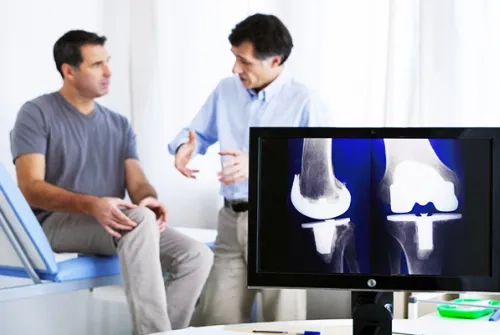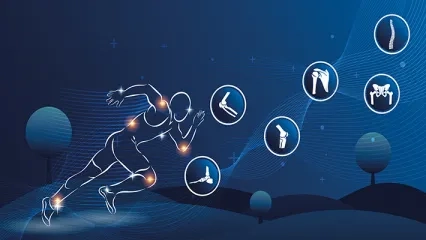Alo Yeditepe
Alo Yeditepe
The Usage Area of Robotic Surgery Expands in Orthopedic Surgeries
Orthopedics and Traumatology specialist Prof. Dr. Hasan Bombacı stated that joint disorders that occur in middle and advanced age due to cartilage deterioration can be treated more effectively with advanced technology surgical methods. Emphasizing that it is possible to get rid of the pain caused by joint disorder, Prof. Dr. Bombacı stated that it is possible to improve the quality of life with joint prosthesis surgeries after a certain stage in these patients whose quality of life decreases due to pain.
He gave information about robotic surgery which has expanded in the field of orthopedics in recent years and has come to the fore with the patient's gains after surgery. “Robotic arthroplasty is the use of robotic technologies in the surgery of replacing joints such as knees, hips or shoulders with prosthetics. “These technologies allow surgeons to perform more precise, accurate and reproducible procedures during surgery.”
Yeditepe University Koşuyolu Hospital Orthopedics and Traumatology Specialist, Prof. Dr.Hasan Bombacı who underlined that the disorders that occur as a result of cartilage deterioration, also known as joint calcification among the people, cause eburnation and difficulty in movement. Dr. Bombacı gave information about robotic surgery, which is preferred in prosthetic surgeries and whose visibility is increasing day by day.
Prof. Dr.Bombacı emphasized that the first complaint of patients with arthrosis is limitation of movement in the affected joint. He explained that individuals often cannot easily move the hip and knee joints in the legs, that intense pain that continues even at rest may be added to this, and that pain and limitation of movement decrease the patient's daily functions and quality of life in the course of time.
Prof. Dr. Bombacı mentioned that there may be people who have had prosthetic surgery and have not seen the expected returns and whose pain has not completely gone away, Prof. Dr. Hasan Bombacı said, “The above mentioned cases can be experienced depending on the medical application or the complications that may develop. On the other hand Robotic Surgery is a surgical method that will minimize these disruptions, and ensures maximum safety and accuracy of the implants during the planning and placement of the prosthesis to the knee.
The Robotic Surgery enables that the cuts make more precise and correctly
Prof. Dr Bombacı underlines that robotic total joint replacement is a surgical technique that allows the surgery to be performed more precisely, Prof. Dr. Bombacı says, “Robotic arthroplasty begins with a planning process that helps the surgeon make better visualisation and more accurate cuts during surgery, firstly. “By directing a robotic arm according to a preplanned procedure, the surgeon places the prosthesis accurately and achieves results closest to the patient's natural articulars.
Underlining that hip joint replacement surgery is one of the most successful surgeries accepted by the World Health Organization (WHO), Prof. Dr. Bombacı continued his words as follows: “We have many colleagues in our country who successfully perform standard prosthetic surgery. It would not be right to say that robotic surgery is good but other methods are bad. However, in some special cases related to the patient, for example, in cases where there are significant bony deformities, calculations need to be done much more precisely. Robotic surgery not only eliminates the negative effects of these malalignments, but also allows prosthesis application with less margin of error in deformities close to normal. In other words, the prosthesis becomes “personalized” in a way by applying it in the most appropriate way to the characteristics of the individual.”
‘’The Robot Indues Compatibility Between Soft Tissue and Bone”
Pointing out that the most important effect of robotic surgery in surgeries is that it provides a smoother incision and planning, Prof. Dr. Bombacı continued his words as follows: “While forming the knee joint during the surgery, we remove the damaged parts of the joint by making cuts at certain angles and amounts on the joint surfaces. Every millimeter and degree of cuts are important when removing these damaged joint parts. These degrees may vary depending on the damage to the patient's knee and the patient's structure. In patients who need prosthesis but arrive late, damage occurs in soft tissues due to alignment and pressure disorders over time. These damages are the conditions that should be taken into account during the prosthesis construction. When we calculate the mentioned soft tissue differences or problems by using the robot, it is possible to evaluate them more precisely. Here, the robot promises us a more precise measurement by ensuring the harmony between soft tissue and bone. Therefore, a better soft tissue and bone balance, a better alignment and result can be obtained in surgeries performed with robots.”
Patients Can Walk On Their Feet On The 2nd Or 3rd Day”
Underlining that the biggest contribution of robotic surgery to the patient is making fewer surgical incisions, Prof. Dr. Bombacı gave the following information about the post-operative period: “The robot, which makes the measurements itself, makes only as many incisions as necessary and allows the procedures to be performed. Since it provides less damage to healthy tissues, recovery and recovery of the patient in the postoperative period results in less pain. In fact, there is not much difference between a patient who underwent robotic surgery in the postoperative period and a patient who underwent well-performed standard prosthetic surgery. In both of them, the patient starts to bear weight after 1-2 days, but the blood loss is less in robotic surgery and the comfort of the patient is higher in the early postoperative period. Thus, the patient can move more easily. A better functional result can be achieved as the placement is close to perfect. After about 2 weeks, the stitches are removed and after almost 3 weeks, it is possible for the patients to return to social life.”
The Situation of the Patient Determines the Surgical Decision”
Pointing out that the timing of prosthetic surgeries in terms of age is also important, Yeditepe University Hospitals Orthopedics and Traumatology specialist Prof. Dr. Hasan Bombacı concluded his words as follows: “Prosthetic surgery is an irreversible operation. The joint surfaces of the patient are completely removed and covered with an implant made of metal with polyethylene in between, but this implant also has a lifespan. Therefore, joint replacement surgeries are not preferred at early ages. The frequency of this surgery starts to increase after about 60-65 years of age. If the person has a rheumatic disease or has had a bad fracture in the knee and the knee joint has been severely damaged, prosthetic surgery may be required at an early age. These are mostly patients with arthrosis who have reached the last stage. Prosthesis surgery is a very pleasing treatment method that promises a more comfortable life for these patients and enables them to return to social life quickly.
About
Faculty and Year of Graduation:
İstanbul Faculty of Medicine, 1986
”
See Also
- What are Hip Joint Diseases? Causes and Treatment
- Robotic Hip Replacement Surgery
- What is Hallux Rigidus (Stiff Big Toe/Toe Arthritis)? Symptoms and Treatment
- What is Hallux Valgus (Bunion)? How is it Treated?
- Ergonomics in Automobiles Prevents Accidents
- Walking and Returning to Social Life After Knee Replacement Surgery
- What Are the Advantages of Robotic Knee Replacement Surgery?
- Robotic Knee Prosthesis Surgery
- Higher Risk of Anterior Cruciate Ligament and Ankle Injury in Female Athletes
- Spinal Fractures
- Big Toes Can Be A Big Problem!
- Hip Osteoarthritis and Hip Prosthesis
- Not Only Athletes Suffer from Meniscus Tears!
- Mistakes While Swimming Can Cause Shoulder Pain
- Myths About Fractures
- The First Onset of Pain in Cartilage Damage in the Knee Should Not Be Overlooked
- Sports Injuries
- 8 Common Misconceptions About Sports Injuries
- Knee Arthritis
- Knee Pain
- Treatment of Knee Arthrosis Varies According to the Person
- A Lack of Attention to Sports Injuries in Children May Affect Their Development
Alo Yeditepe




